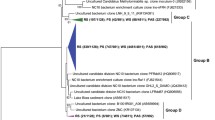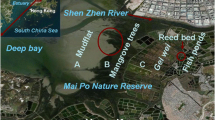Abstract
“Candidatus Methylomirabilis oxyfera” (M. oxyfera) bacteria has attracted much attention recently since it plays an important role in performing methane oxidation. Most studies on M. oxyfera-like bacteria have been carried out in freshwater ecosystems, however it remains unclear about its distribution along the salinity gradient of estuarine and coastal environments. In this study, we used molecular analyses to reveal the community, diversity and abundance of M. oxyfera-like bacteria in the Yangtze estuarine and coastal sediments. Clone library analyses confirmed the wide distributions of M. oxyfera-like bacterial 16S rRNA and pmoA genes in the study area. The M. oxyfera-like bacterial 16S rRNA gene sequences were grouped into eleven separate OTUs, which were assigned to groups A and B of M. oxyfera-like bacteria. Most sequences (89.4–97.6% of total sequences) of M. oxyfera-like bacterial 16S rRNA gene were affiliated with group B, while only few clone sequences (2.4–10.6% of total sequences) were affiliated with group A. The retrieved M. oxyfera-like bacterial pmoA gene sequences were grouped into five distinct clusters. Bray–Curtis dissimilarity of M. oxyfera-like bacterial 16S rRNA and pmoA genes differed greatly among the low, middle and high salinity sites. M. oxyfera-like bacterial 16S rRNA and pmoA abundances were mainly recovered from the oligohaline sites rather than from the saline sites. In addition, the large differences in 16S rRNA and pmoA gene sequences between estuarine and land freshwater environments suggested that salinity could be able to affect the community distribution of M. oxyfera-like bacteria. Also, sediment nitrate/ammonium played an important role in affecting the M. oxyfera-like bacteria. Overall, these results indicate that salinity has a great influence on M. oxyfera-like bacteria community in estuarine environments.







Similar content being viewed by others
References
Chen X, Zhong Y (1998) Coastal erosion along the Changjiang deltaic shoreline, China: history and prospective. Estuar Coast Shelf Sci 46:733–742
Chen J, Zhou ZC, Gu JD (2014) Occurrence and diversity of nitrite dependent anaerobic methane oxidation bacteria in the sediments of the South China Sea revealed by amplification of both 16S rRNA and pmoA genes. Appl Microbiol Biot 98:5685–5696
Chen J, Zhou ZC, Gu JD (2015) Complex community of nitrite-dependent anaerobic methane oxidation bacteria in coastal sediments of the Mai Po wetland by PCR amplification of both 16S rRNA and pmoA genes. Appl Microbiol Biot 99(3):1463–1473
Crump BC, Hopkinson CS, Sogin ML, Hobbie JE (2004) Microbial biogeography along an estuarine salinity gradient: combined influences of bacterial growth and residence time. Appl Environ Microbiol 70:1494–1505
Dahnke K, Bahlmann E, Emeis K (2008) A nitrate sink in estuaries? An assessment by means of stable nitrate isotopes in the Elbe estuary. Limnol Oceanogr 53:1504–1511
Delgado-Baquerizo M, Oliverio AM, Brewer TE, Benavent-González A, Eldridge DJ, Bardgett RD, Maestre FT, Singh BK, Fierer N (2018) A global atlas of the dominant bacteria found in soil. Science 359(6373):320–325
Deng FY, Hou LJ, Liu M, Zheng YL, Yin GY, Li XF, Lin XB, Chen F, Gao J, Jiang XF (2015) Dissimilatory nitrate reduction processes and associated contribution to nitrogen removal in sediments of the Yangtze Estuary. J Geophys Res Biogeosci 120(8):1521–1531
Deng YC, Liu YQ, Dumont M, Conrad R (2017) Salinity affects the composition of the aerobic methanotroph community in alkaline lake sediments from the Tibetan Plateau. Microb Ecol 73:101–110
Deutzmann JS, Schink B (2011) Anaerobic oxidation of methane in sediments of Lake Constance, an oligotrophic freshwater lake. Appl Environ Microbiol 77(13):4429–4436
Deutzmann JS, Stief P, Brandes J, Schink B (2014) Anaerobic methane oxidation coupled to denitrification is the dominant methane sink in a deep lake. Proc Natl Acad Sci USA 111(51):18273–18278
Egger M, Rasigraf O, Sapart CJ, Jilbert T, Jetten MSM, Röckmann T, van der Veen C, Bândă N, Kartal B, Ettwig KF, Slomp CP (2014) Iron-mediated anaerobic oxidation of methane in Brackish coastal sediments. Environ Sci Technol 49(1):277–283
Ettwig KF, van Alen T, van de Pas-Schoonen KT, Jetten MSM, Strous M (2009) Enrichment and molecular detection of denitrifying methanotrophic bacteria of the NC10 phylum. Appl Environ Microbiol 75(11):3656–3662
Ettwig KF, Butler MK, Paslier D, Pelletie E, Mangenot S, Kuypers MMM, Schreiber F, Dutilh BE, Zedelius J, de Beer D, Gloerich J, Wessels HJCT, van Alen T, Luesken F, Wu ML, van de Pas-Schoonen KT, Op den Camp HJM, Janssen-Megens EM, Francoijs KJ, Stunnenberg H, Weissenbach J, Jetten MSM, Strous M (2010) Nitrate driven anaerobic methane oxidation by oxygenic bacteria. Nature 464:543–550
Gupta V, Smemo KA, Yavitt JB, Fowle D, Branfireun B, Basiliko N (2013) Stable isotopes reveal widespread anaerobic methane oxidation across latitude and peatland type. Environ Sci Technol 47(15):8273–8279
Haroon MF, Hu S, Shi Y, Imelfort M, Keller J, Hugenholtz P, Yuan Z, Tyson GW (2013) Anaerobic oxidation of methane coupled to nitrate reduction in a novel archaeal lineage. Nature 500:567–570
He ZF, Geng S, Cai CY, Liu S, Liu Y, Pan YW, Lou LP, Zheng P, Hu BL (2015) Anaerobic oxidation of methane coupled to nitrite reduction by halophilic marine NC10 bacteria. Appl Environ Microbiol 81(16):5538–5545
Hou LJ, Zheng YL, Liu M, Gong J, Zhang XL, Yin GY, You LL (2013) Anaerobic ammonium oxidation (anammox) bacterial diversity, abundance, and activity in marsh sediments of the Yangtze Estuary. J Geophys Res Biogeosci 118:237–1246
Hu BL, Shen LD, Lian X, Zhu Q, Liu S, Huang Q, He ZF, Geng S, Cheng DQ, Lou LP, Xu XY, Zheng P, He YF (2014) Evidence for nitrite-dependent anaerobic methane oxidation as a previously overlooked microbial methane sink in wetlands. Proc Natl Acad Sci USA 111(12):4495–4500
IPCC (2014) Summary for policymakers. In: Climate change 2014: impacts, adaptation, and vulnerability. Part A: global and sectoral aspects. Contribution of Working Group II to the Fifth Assessment Report of the Intergovernmental Panel on Climate Change. Cambridge University Press, Cambridge, UK and New York, NY, USA, pp 1–32
Kojima H, Tsutsumi M, Ishikawa K, Iwata T, Mußmann M, Fukui M (2012) Distribution of putative denitrifying methane oxidizing bacteria in sediment of a freshwater lake, Lake Biwa. Syst Appl Microbiol 35(4):233–238
Komada T, Burdige DJ, Li HL, Magen C, Chanton J, Cada AK (2016) Organic matter cycling across the sulfate-methane transition zone of the Santa Barbara Basin, California Borderland. Geochim Cosmochim Acta 176:259–278
Lovley DR, Phillips EJP (1987) Rapid assay for microbially reducible ferric iron in aquatic sediments. Appl Environ Microbiol 5:1536–1540
Luesken FA, Sánchez J, van Alen TA, Danabria J, Op den Camp HJM, Jetten MSM, Kartal B (2011a) Stimultaneous nitrite-dependent anaerobic methane and ammonium oxidation processes. Appl Environ Microbiol 77:6802–6907
Luesken FA, Zhu BL, van Alen TA, Butler MK, Diaz MR, Song B, Op den Camp HJM, Jetten MSM, Ettwig KF (2011b) pmoA primers for detection of anaerobic methanotrophs. Appl Environ Microbiol 77(11):3877–3880
Morrissey EM, Gillespie JL, Morina JC, Franklin RB (2014) Salinity affects microbial activity and soil organic matter content in tidal wetlands. Glob Change Biol 20:1351–1362
Norði K, Thamdrup B (2014) Nitrate-dependent anaerobic methane oxidation in a freshwater sediment. Geochim Cosmochim Acta 132:141–150
Osudar R, Klings KW, Wagner D, Bussmann I (2017) Effect of salinity on microbial methane oxidation in freshwater and marine environments. Aquat Microb Ecol 80(2):181–192
Pfeiffer-Herbert AS, Prahl FG, Hales B, Lerczak JA, Pierce SD, Levine MD (2016) High resolution sampling of methane transport in the Columbia River near-field plume: Implications for sources and sinks in a river-dominated estuary. Limnol Oceanogr 61:S204–S220
Raghoebarsing AA, Pol A, van de Pas-Schoonen KT, Smolders AJP, Ettwig KF, Rijpstra WIC, Schouten S, Damsté JSS, Op den Cam HJM, Jetten MSM, Strous M (2006) A microbial consortium couples anaerobic methane oxidation to denitrification. Nature 440:918–921
Schloss PD, Westcott SL, Ryabin T, Hall JR, Hartmann M, Hollister EB, Lesniewski RA, Oakley BB, Parks DH, Robinson CJ, Sahl JW, Stres B, Thallinger GG, Van Horn DJ, Weber CF (2009) Introducing mothur: open-source, platform-independent, community-supported software for describing and comparing microbial communities. Appl Environ Microbiol 75:7537–7541
Seo DC, Yu K, Delaune RD (2008) Influence of salinity level on sediment denitrification in a Louisiana estuary receiving diverted Mississippi River water. Arch Agron Soil Sci 54:249–257
Shen LD, Liu S, Zhu Q, Li XY, Cai C, Cheng DQ, Lou LP, Xu XY, Zheng P, Hu BL (2014a) Distribution and diversity of nitrite-dependent anaerobic methane-oxidising bacteria in the sediments of the Qiantang River. Microb Ecol 37:341–349
Shen LD, Zhu Q, Liu S, Du P, Zeng JN, Chbn DQ, Cheng DQ, Xu XY, Zheng P, Hu BL (2014b) Molecular evidence for nitrite-dependent anaerobic methane-oxidising bacteria in the Jiaojiang Estuary of the East Sea (China). Appl Microbiol Biot 98(11):5029–5038
Shen LD, Liu S, He ZF, Lian X, Huang Q, He YF, Lou LP, Xu XY, Zheng P, Hu BL (2015) Depth-specific distribution and importance of nitrite-dependent anaerobic ammonium and methane-oxidising bacteria in an urban wetland. Soil Biol Biochem 83:43–51
Shen LD, Hu BL, Liu S, Chai XP, He ZF, Ren HX, Liu Y, Geng S, Wang W, Tang JL, Wang YM, Lou LP, Xu XY, Zheng P (2016) Anaerobic methane oxidation coupled to nitrite reduction can be a potential methane sink in coastal environments. Appl Microbiol Biot 100(16):7171–7180
Shoemaker WR, Locey KJ, Lennon JT (2017) A macroecological theory of microbial biodiversity. Nature Ecol Evol 1(5):0107
Simpson IJ, Chen TY, Blake DR, Rowland FS (2002) Implications of the recent fluctuations in the growth rate of tropospheric methane. Geophys Res Lett 29(10):1479. https://doi.org/10.1029/2001GL014521
Sivan O, Adler M, Pearson A, Gelman F, Bar-Or I, John SG, Eckert W (2011) Geochemical evidence for iron-mediated anaerobic oxidation of methane. Limnol Oceanogr 56(4):1536–1544
Tamura K, Dudley J, Nei M, Kumar S (2007) MEGA4: molecular evolutionary genetics analysis (MEGA) software version 4.0. Mol Biol Evol 24:1596–1599
Thompson JD, Gibson TJ, Plewniak F, Jeanmougin F, Higgins DG (1997) The CLUSTALX windows interface: flexible strate-gies for multiple sequence alignment aided by quality analysis tools. Nucleic Acids Res 25:4876–4882
Wang JQ, Shen LD, He ZF, Hu JJ, Cai ZY, Zheng P, Hu BL (2017) Spatial and temporal distribution of nitrite-dependent anaerobic methane-oxidizing bacteria in an intertidal zone of the East China Sea. Appl Microbiol Biot 101(21):8007–8014
Welti N, Hayes M, Lockington D (2017) Seasonal nitrous oxide and methane emissions across a subtropical estuarine salinity gradient. Biogeochemistry 132(1–2):55–69
Yan PZ, Li MC, Wei GS, Li H, Gao Z (2015) Molecular fingerprint and dominant environmental factors of nitrite-dependent anaerobic methane-oxidizing bacteria in sediments from the Yellow River Estuary, China. PLoS ONE 10(9):e0137996
Zhu GB, Zhou LL, Wang Y, Wang SY, Guo JH, Long XE, Sun XB, Jiang B, Hou QY, Jetten MSM, Yin CQ (2015) Biogeographical distribution of denitrifying anaerobic methane oxidizing bacteria in Chinese wetland ecosystems. Environ Microbiol Rep 7(1):128–138
Acknowledgements
This work was supported by the National Natural Science Foundation of China (Grant Numbers 41761144062, 41725002 and 41701548) and the Foundation for Excellent Young Scholar of Fujian Normal University. We thank the three anonymous reviewers for their constructive comments on the early version of our manuscript. We also thank American Journal Experts for the language improvement of this manuscript.
Author information
Authors and Affiliations
Corresponding author
Additional information
Responsible Editor: Leila J. Hamdan.
Publisher's Note
Springer Nature remains neutral with regard to jurisdictional claims in published maps and institutional affiliations.
Electronic supplementary material
Below is the link to the electronic supplementary material.
Rights and permissions
About this article
Cite this article
Li, X., Gao, D. & Liu, M. Composition, diversity and abundance of Candidatus M. oxyfera-like bacteria in response to the estuary salinity gradient. Biogeochemistry 143, 1–14 (2019). https://doi.org/10.1007/s10533-019-00545-w
Received:
Accepted:
Published:
Issue Date:
DOI: https://doi.org/10.1007/s10533-019-00545-w




